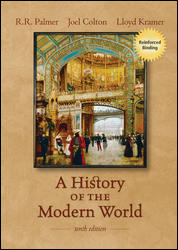
History of the Modern World, 10th Edition (Palmer)Chapter 22: The Cold War and Reconstruction After the Second World WarChapter OverviewThe aftermath of the Second World War brought challenges from the realms of science, the organization of industrial society, and issues of national sovereignty. The Cold War, a conflict stemming from the conflicting ideologies of capitalism and communism and the relative strength of both the Soviet Union and the U.S. after WWII, shaped international relations for decades to come. The U.S. policy of containment led Americans into indirect conflicts with the Soviets in Europe, Asia, Africa, and Latin America as they sought to combat Soviet expansionism. Meanwhile, western Europe struggled to recover from the damages of the war, and with the aid granted by the Marshall Plan, experienced prosperity in the 1950s and ‘60s. Britain struggled the most to stimulate its economy, and confronted further problems with Northern Ireland. The Fourth Republic of France fell as a result of the war with Algiers, but stability was reestablished under De Gaulle. Italy and West Germany were transformed into democratic republics. The world economy was transformed by renewed efforts to establish international standards and to facilitate the expansion of the global economy. Europe moved closer to unification, at least economically. In eastern Europe, the Soviets consolidated their control, while in China, Mao Zedong and the Communists attempted to rapidly modernize the country and reinforce revolutionary zeal. |  |















